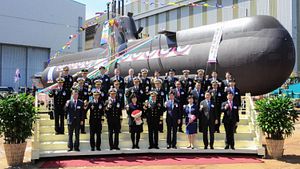South Korea has become a major arms exporter as Seoul is trying to boost its defense capabilities in the face of continuous missile and nuclear threats from North Korea, a Swedish think tank said on December 11.
The Stockholm International Peace Research Institute (SIPRI) stated in a report listing the world’s “top 100” arms producers that arms sales by South Korean companies rose by 20.6 percent in comparison to the previous year, with total sales amounting to $8.4 billion in 2016.
According to SIPRI, South Korea dominates arms sales in the emerging producers category, which also includes Brazil, India, and Turkey.
“Continuing and rising threat perceptions drive South Korea’s acquisitions of military equipment, and it is increasingly turning to its own arms industry to supply its demand for weapons,” said SIPRI researcher Siemon Wezeman. “At the same time, South Korea is aiming to realize its goal of becoming a major arms exporter.”
South Korea began to build up its defense industry under the Park Chung-hee administration in the 1970s. Around 100 defense companies are currently producing defense equipment for domestic and international customers, including Samsung, Korea Aerospace Industries, and LIG Nex1. This number rises t0 around 400 when affiliates are included.
The defense industry produces a wide range of products.
For example, South Korea has burgeoning ballistic and cruise missile programs, and has built one of the world’s most advanced self-propelled 155-millimeter howitzers, the K9 Thunder. The Hyundai Rotem K2 (Black Panther) is considered to be one of the world’s best main battle tanks (MBT) and serves as the basis for a possible new tank for the Turkish military.
Furthermore, Europe’s Airbus helicopters and Korea Aerospace Industries (KAI) are jointly developing the next-generation Light Civil Helicopter (LCH) and the Light Armed Helicopter (LAH) for an estimated $1.4 billion. KAI is also working on a next-generation stealth fighter jet, the KF-X, in partnership with Indonesia’s defense industry.
Hyundai Heavy Industries license-produces German diesel-electric attack submarines for the Republic of Korea Navy (ROKN). Another South Korean defense contractor, Daewoo Shipbuilding and Marine Engineering, is building license-built variants of the German Type 209 attack sub for the Indonesian Navy, among other things.
However, South Korea’s defense industry continues to face a number of difficulties. For one thing, it has repeatedly been hampered by corruption allegations, which has slowed down both the export and import of new defense equipment. Delays are also often amplified by various technical problems with new military hardware, which are difficult to address given South Korea’s rigid corporate culture.
Overall, the world’s 100 biggest arms producers increased sales by 1.9 percent from the previous year to reach $375 billion. This constitutes the first year of growth in SIPRI Top 100 arms sales after five consecutive years of decline. Overall, this represents an increase of 38 percent in global arms sales from the top 100 defense companies since 2002.
“The growth in arms sales was expected and was driven by the implementation of new national major weapon programs, ongoing military operations in several countries and persistent regional tensions that are leading to an increased demand for weapons,” SIPRI notes.
































